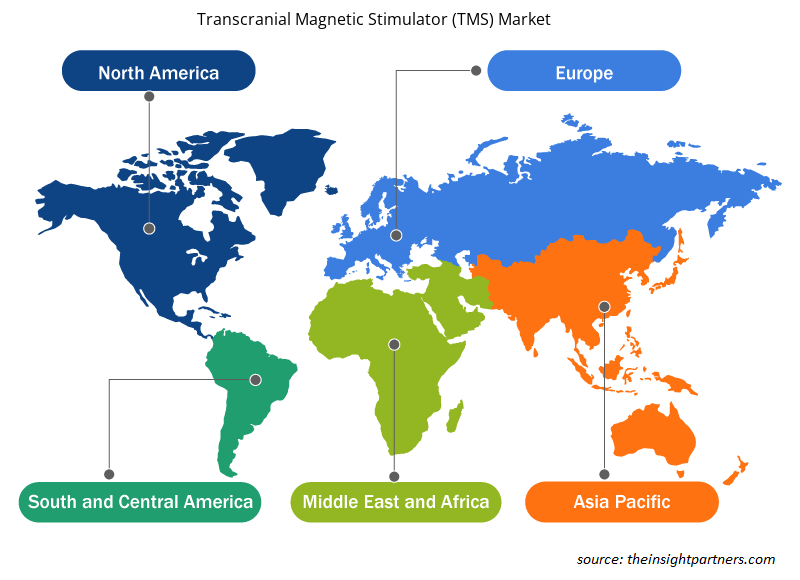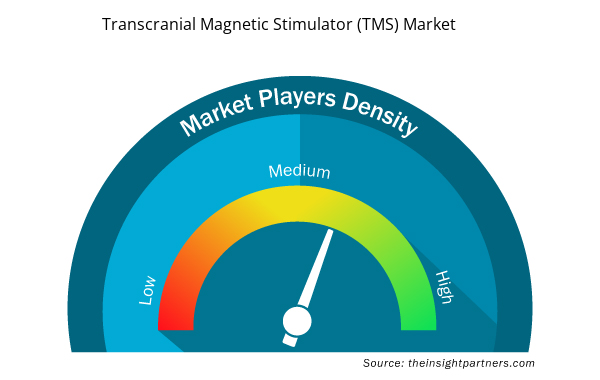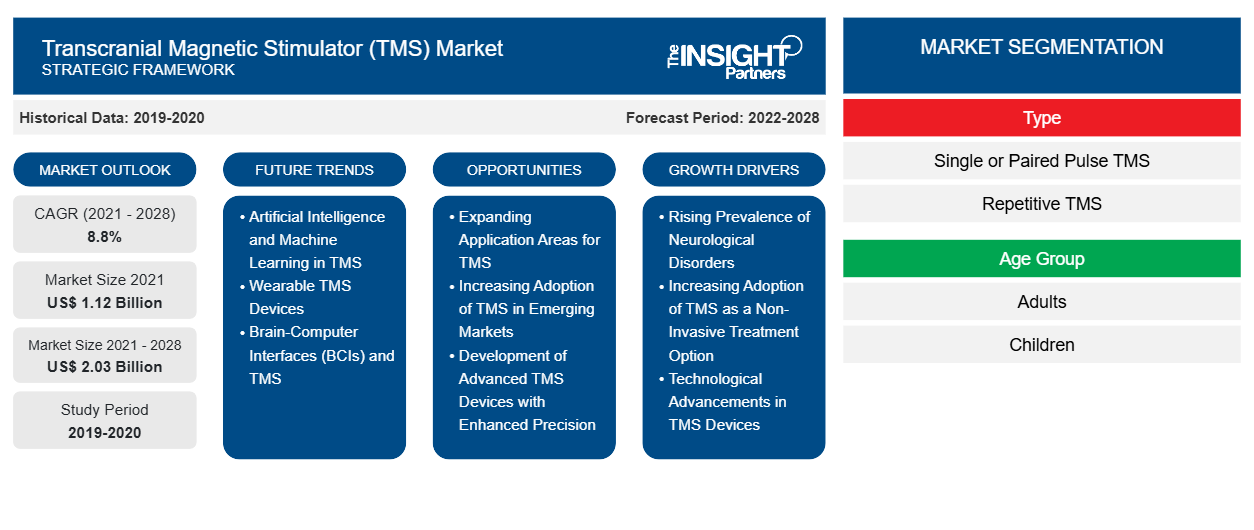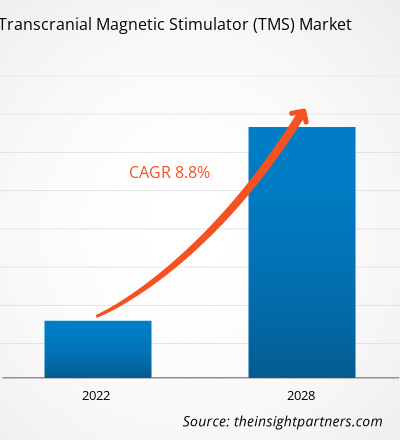[Informe de investigación] Se proyecta que el mercado de estimuladores magnéticos transcraneales (TMS) alcance los US$ 2.029,71 millones para 2028 desde los US$ 1.122,22 millones en 2021; se espera que registre una CAGR del 8,8% entre 2021 y 2028.
Los trastornos neurológicos afectan el cerebro y los nervios del cuerpo humano y causan epilepsia y convulsiones, enfermedad de Parkinson, demencia, autismo, enfermedad de Alzheimer, tumores cerebrales y parálisis cerebral, entre otros. La prevalencia de los trastornos neurológicos está aumentando en todo el mundo. Según el Estudio de la Carga Global de Enfermedades (GBD) 2017, la enfermedad de Alzheimer y otras demencias [2,55 millones de años de vida ajustados por discapacidad (AVAD)], el accidente cerebrovascular [alrededor de 3,58 millones de AVAD] y la migraña (alrededor de 2,40 millones de AVAD) fueron las tres enfermedades neurológicas más gravosas en los EE. UU. en términos de un número total de años de vida ajustados por discapacidad.
Además, la Asociación de Alzheimer estima que más de 6 millones de estadounidenses padecen la enfermedad de Alzheimer y se proyecta que la cifra alcance casi los 13 millones en 2050. El estimulador magnético transcraneal (EMT) se utiliza ampliamente para el diagnóstico y tratamiento de trastornos neurológicos. Por ejemplo, según BrainsWay Ltd., en abril de 2021, 100.000 pacientes en todo el mundo fueron tratados con su EMT profunda. Por tanto, la creciente prevalencia de los trastornos neurológicos impulsa el crecimiento del mercado del estimulador magnético transcraneal (EMT) a nivel mundial. Además, la depresión es uno de los trastornos mentales que se observan con más frecuencia entre las personas de todo el mundo. Según los datos publicados por la OMS en enero de 2020, más de 264 millones de personas de todas las edades padecen depresión en todo el mundo.
Personalice este informe según sus necesidades
Obtendrá personalización en cualquier informe, sin cargo, incluidas partes de este informe o análisis a nivel de país, paquete de datos de Excel, así como también grandes ofertas y descuentos para empresas emergentes y universidades.
- Obtenga las principales tendencias clave del mercado de este informe.Esta muestra GRATUITA incluirá análisis de datos, desde tendencias del mercado hasta estimaciones y pronósticos.
Perspectivas del mercado
La estimulación magnética transcraneal (EMT) es un procedimiento no invasivo que ayuda a tratar trastornos neurológicos. Además, los crecientes avances tecnológicos en el campo de la EMT han aumentado sus aplicaciones. Las empresas que operan en el mercado de la estimulación magnética transcraneal (EMT) están adoptando diversas estrategias, como la obtención de aprobaciones de la Administración de Alimentos y Medicamentos (FDA) para sus productos innovadores, asociaciones comerciales y la recaudación de fondos para el desarrollo de productos, lo que impulsa el crecimiento del mercado.
A continuación se presentan algunos ejemplos de desarrollos:
- En marzo de 2021, MagVenture presentó MagVenture Flow Arm, un sistema de posicionamiento clínico pendiente de patente, diseñado para optimizar la administración de los protocolos aprobados por la FDA de MagVenture para la tecnología de estimulación cerebral no invasiva para el tratamiento del trastorno depresivo mayor y como terapia complementaria para el trastorno obsesivo compulsivo (TOC).
- En agosto de 2020, la terapia TMS de MagVenture recibió la autorización de la FDA para el tratamiento complementario del TOC. Es la segunda indicación en los EE. UU. para la empresa danesa de dispositivos médicos MagVenture.
- En febrero de 2019, eNeura, Inc., una empresa privada de tecnología médica, anunció una nueva autorización 510(k) de la FDA. Con la autorización, la empresa afirmó que la sTMS es el único producto para la migraña en los EE. UU. para el tratamiento de dolores de cabeza por migraña agudos y profilácticos en adultos y niños (de 12 años o más).
Por lo tanto, se espera que la participación activa de los actores globales en el desarrollo de la estimulación magnética transcraneal y tecnologías relacionadas respalde el crecimiento del mercado.
Perspectivas basadas en tipos
Según el tipo, el mercado de estimuladores magnéticos transcraneales (EMT) se segmenta en EMT de pulso único o en pares y EMT repetitiva (EMTr). En 2021, el segmento de EMT de pulso único o en pares tenía una mayor participación en el mercado. Sin embargo, se espera que el segmento de EMT repetitiva (EMTr) experimente una CAGR más alta durante 2021-2028.
Perspectivas basadas en aplicaciones
Según la aplicación, el mercado se segmenta en investigación, diagnóstico y terapia. En 2021, el segmento de diagnóstico tuvo la mayor participación del mercado y se espera que crezca a la tasa de crecimiento anual compuesta más alta durante los próximos años.
Las empresas que operan en el mercado de estimuladores magnéticos transcraneales (TMS) enfatizan en adoptar la estrategia de innovaciones de productos para satisfacer las cambiantes demandas de los clientes en todo el mundo, lo que también les permite mantener su marca en el mercado global.
Alcance del informe de mercado sobre estimuladores magnéticos transcraneales
Perspectivas regionales del mercado de estimuladores magnéticos transcraneales (TMS)
Los analistas de Insight Partners explicaron en detalle las tendencias y los factores regionales que influyen en el mercado de estimuladores magnéticos transcraneales (TMS) durante el período de pronóstico. Esta sección también analiza los segmentos y la geografía del mercado de estimuladores magnéticos transcraneales (TMS) en América del Norte, Europa, Asia Pacífico, Oriente Medio y África, y América del Sur y Central.

- Obtenga datos regionales específicos para el mercado de estimuladores magnéticos transcraneales (TMS)
Alcance del informe de mercado sobre estimuladores magnéticos transcraneales (TMS)
| Atributo del informe | Detalles |
|---|---|
| Tamaño del mercado en 2021 | 1.120 millones de dólares estadounidenses |
| Tamaño del mercado en 2028 | US$ 2.03 mil millones |
| CAGR global (2021-2028) | 8,8% |
| Datos históricos | 2019-2020 |
| Período de pronóstico | 2022-2028 |
| Segmentos cubiertos | Por tipo
|
| Regiones y países cubiertos | América del norte
|
| Líderes del mercado y perfiles de empresas clave |
|
Densidad de actores del mercado: comprensión de su impacto en la dinámica empresarial
El mercado de estimuladores magnéticos transcraneales (TMS) está creciendo rápidamente, impulsado por la creciente demanda de los usuarios finales debido a factores como la evolución de las preferencias de los consumidores, los avances tecnológicos y una mayor conciencia de los beneficios del producto. A medida que aumenta la demanda, las empresas amplían sus ofertas, innovan para satisfacer las necesidades de los consumidores y aprovechan las tendencias emergentes, lo que impulsa aún más el crecimiento del mercado.
La densidad de actores del mercado se refiere a la distribución de las empresas o firmas que operan dentro de un mercado o industria en particular. Indica cuántos competidores (actores del mercado) están presentes en un espacio de mercado determinado en relación con su tamaño o valor total de mercado.
Las principales empresas que operan en el mercado de estimuladores magnéticos transcraneales (TMS) son:
- BrainsWay Ltd
- Siguiente
- Magstim
- Neuronética
- Soluciones neurológicas TMS
Descargo de responsabilidad : Las empresas enumeradas anteriormente no están clasificadas en ningún orden particular.

- Obtenga una descripción general de los principales actores clave del mercado de estimuladores magnéticos transcraneales (TMS)
Segmentación del mercado de estimuladores magnéticos transcraneales (EMT)
Por tipo
- TMS de pulso único o en pares
- EMT repetitiva (EMTr)
Por grupo de edad
- Adultos
- Niños
Por aplicación
- Investigación
- Diagnóstico
- Terapéutico
Por geografía
- América del norte
- A NOSOTROS
- Canadá
- México
- Europa
- Francia
- Alemania
- Italia
- Reino Unido
- España
- Resto de Europa
- Asia Pacífico (APAC)
- Porcelana
- India
- Corea del Sur
- Japón
- Australia
- Resto de APAC
- Oriente Medio y África (MEA)
- Sudáfrica
- Arabia Saudita
- Emiratos Árabes Unidos
- Resto de MEA
- América del Sur y Central (SCAM)
- Brasil
- Argentina
- Resto de estafa
Perfiles de empresas
- BrainsWay Ltd
- Nexstim, Magstim
- Neuronética
- Soluciones neurológicas TMS
- Empresa
- Compañía: eNeura Inc.
- Neurosoft
- MAG & More GmbH
- Análisis histórico (2 años), año base, pronóstico (7 años) con CAGR
- Análisis PEST y FODA
- Tamaño del mercado Valor/volumen: global, regional, nacional
- Industria y panorama competitivo
- Conjunto de datos de Excel



Report Coverage
Revenue forecast, Company Analysis, Industry landscape, Growth factors, and Trends

Segment Covered
This text is related
to segments covered.

Regional Scope
North America, Europe, Asia Pacific, Middle East & Africa, South & Central America

Country Scope
This text is related
to country scope.
Preguntas frecuentes
Asia Pacific is expected to be the fastest-growing region and is likely to expand at a high growth rate due to large geriatric population, rising numbers of neurological disorders are among the factors expected to drive the market in the region during the forecast period.
The global Transcranial Magnetic Stimulator (TMS) market based on type is segmented into Single or paired pulse TMS and Repetitive TMS (rTMS). In 2021, the Single or paired pulse TMS segment held the largest share of the market, by type. The Repetitive TMS (rTMS) segment of Transcranial Magnetic Stimulator (TMS) market is also expected to witness fastest CAGR during 2021 to 2028..
The Transcranial Magnetic Stimulator (TMS) market majorly consists of the players such as BrainsWay Ltd, Nexstim, Magstim, Neuronetics, TMS Neuro Solutions, MagVenture, Inc., eNeura Inc., Neurosoft, MAG & More GmbH. REMED among others amongst others.
The US is the largest market for Transcranial Magnetic Stimulator (TMS) at a global level. The US is the largest and fastest-growing market for the TMS market. The market growth is attributed to increasing developments of the medical device sector for neuromodulation, significantly rising incidences of neurological disorders among people and growing demand for neuromodulation devices for chronic pain management. In addition, the economic burden to treat neurological disorders is significantly growing in the country. For instance, according to a study published by the American Neurological Association in March 2017, ~US$ 800 billion is spent per year for treating neurological disorders. The cost of treatment affects ~100 million people every year across the country. It is also estimated that the treatment cost of dementia and stroke alone is estimated to reach over US$ 600 billion in 2030.
The factors that are driving and restraining factors that will affect Transcranial Magnetic Stimulator (TMS) market in the coming years. Factors such as rising prevalence of neurological disorders, growing developments in transcranial magnetic stimulation technology are driving the market growth. However, high cost of diagnostic and treatment are likely to hamper the growth of the market.
Transcranial Magnetic Stimulator (TMS), also referred to us repetitive Transcranial Magnetic Stimulator (rTMS), is a type of brain stimulation in which a changing magnetic field is applied to a specific area of the brain. An electric pulse stimulator is attached to a magnetic coil, which is then connected to the scalp. It is a non-invasive procedure and is used for diagnostic and therapeutic applications.
Trends and growth analysis reports related to Life Sciences : READ MORE..
The List of Companies - Transcranial Magnetic Stimulator (TMS) Market
- BrainsWay Ltd
- Nexstim
- Magstim
- Neuronetics
- TMS Neuro Solutions
- MagVenture, Inc.
- eNeura Inc.
- Neurosoft
- MAG & More GmbH.
- REMED
The Insight Partners performs research in 4 major stages: Data Collection & Secondary Research, Primary Research, Data Analysis and Data Triangulation & Final Review.
- Data Collection and Secondary Research:
As a market research and consulting firm operating from a decade, we have published and advised several client across the globe. First step for any study will start with an assessment of currently available data and insights from existing reports. Further, historical and current market information is collected from Investor Presentations, Annual Reports, SEC Filings, etc., and other information related to company’s performance and market positioning are gathered from Paid Databases (Factiva, Hoovers, and Reuters) and various other publications available in public domain.
Several associations trade associates, technical forums, institutes, societies and organization are accessed to gain technical as well as market related insights through their publications such as research papers, blogs and press releases related to the studies are referred to get cues about the market. Further, white papers, journals, magazines, and other news articles published in last 3 years are scrutinized and analyzed to understand the current market trends.
- Primary Research:
The primarily interview analysis comprise of data obtained from industry participants interview and answers to survey questions gathered by in-house primary team.
For primary research, interviews are conducted with industry experts/CEOs/Marketing Managers/VPs/Subject Matter Experts from both demand and supply side to get a 360-degree view of the market. The primary team conducts several interviews based on the complexity of the markets to understand the various market trends and dynamics which makes research more credible and precise.
A typical research interview fulfils the following functions:
- Provides first-hand information on the market size, market trends, growth trends, competitive landscape, and outlook
- Validates and strengthens in-house secondary research findings
- Develops the analysis team’s expertise and market understanding
Primary research involves email interactions and telephone interviews for each market, category, segment, and sub-segment across geographies. The participants who typically take part in such a process include, but are not limited to:
- Industry participants: VPs, business development managers, market intelligence managers and national sales managers
- Outside experts: Valuation experts, research analysts and key opinion leaders specializing in the electronics and semiconductor industry.
Below is the breakup of our primary respondents by company, designation, and region:

Once we receive the confirmation from primary research sources or primary respondents, we finalize the base year market estimation and forecast the data as per the macroeconomic and microeconomic factors assessed during data collection.
- Data Analysis:
Once data is validated through both secondary as well as primary respondents, we finalize the market estimations by hypothesis formulation and factor analysis at regional and country level.
- Macro-Economic Factor Analysis:
We analyse macroeconomic indicators such the gross domestic product (GDP), increase in the demand for goods and services across industries, technological advancement, regional economic growth, governmental policies, the influence of COVID-19, PEST analysis, and other aspects. This analysis aids in setting benchmarks for various nations/regions and approximating market splits. Additionally, the general trend of the aforementioned components aid in determining the market's development possibilities.
- Country Level Data:
Various factors that are especially aligned to the country are taken into account to determine the market size for a certain area and country, including the presence of vendors, such as headquarters and offices, the country's GDP, demand patterns, and industry growth. To comprehend the market dynamics for the nation, a number of growth variables, inhibitors, application areas, and current market trends are researched. The aforementioned elements aid in determining the country's overall market's growth potential.
- Company Profile:
The “Table of Contents” is formulated by listing and analyzing more than 25 - 30 companies operating in the market ecosystem across geographies. However, we profile only 10 companies as a standard practice in our syndicate reports. These 10 companies comprise leading, emerging, and regional players. Nonetheless, our analysis is not restricted to the 10 listed companies, we also analyze other companies present in the market to develop a holistic view and understand the prevailing trends. The “Company Profiles” section in the report covers key facts, business description, products & services, financial information, SWOT analysis, and key developments. The financial information presented is extracted from the annual reports and official documents of the publicly listed companies. Upon collecting the information for the sections of respective companies, we verify them via various primary sources and then compile the data in respective company profiles. The company level information helps us in deriving the base number as well as in forecasting the market size.
- Developing Base Number:
Aggregation of sales statistics (2020-2022) and macro-economic factor, and other secondary and primary research insights are utilized to arrive at base number and related market shares for 2022. The data gaps are identified in this step and relevant market data is analyzed, collected from paid primary interviews or databases. On finalizing the base year market size, forecasts are developed on the basis of macro-economic, industry and market growth factors and company level analysis.
- Data Triangulation and Final Review:
The market findings and base year market size calculations are validated from supply as well as demand side. Demand side validations are based on macro-economic factor analysis and benchmarks for respective regions and countries. In case of supply side validations, revenues of major companies are estimated (in case not available) based on industry benchmark, approximate number of employees, product portfolio, and primary interviews revenues are gathered. Further revenue from target product/service segment is assessed to avoid overshooting of market statistics. In case of heavy deviations between supply and demand side values, all thes steps are repeated to achieve synchronization.
We follow an iterative model, wherein we share our research findings with Subject Matter Experts (SME’s) and Key Opinion Leaders (KOLs) until consensus view of the market is not formulated – this model negates any drastic deviation in the opinions of experts. Only validated and universally acceptable research findings are quoted in our reports.
We have important check points that we use to validate our research findings – which we call – data triangulation, where we validate the information, we generate from secondary sources with primary interviews and then we re-validate with our internal data bases and Subject matter experts. This comprehensive model enables us to deliver high quality, reliable data in shortest possible time.


 Obtenga una muestra gratuita de este informe
Obtenga una muestra gratuita de este informe